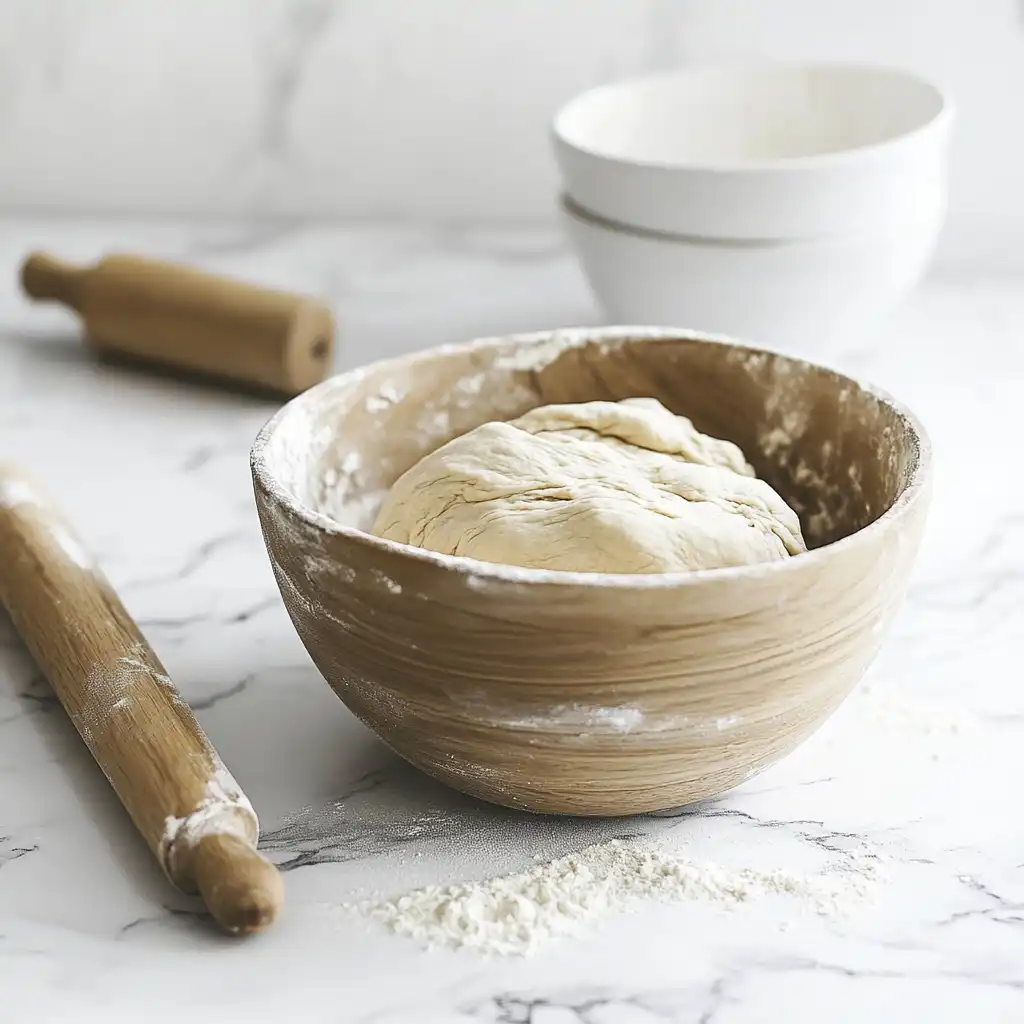Making the perfect Swiss croissant at home is a delicious and rewarding experience. If you’ve ever tried a Swiss croissant at a bakery and wondered how to recreate that flaky, buttery goodness in your own kitchen, you’re in the right place. This guide will take you through everything from the dough and ingredients to shaping and baking tips, so you can enjoy a freshly baked batch at home. Whether you’re new to baking or a seasoned pro, you’ll find helpful tips, tricks, and fun ideas to make the process a breeze. So, let’s get started!
You can learn more about the Swiss version of the croissant in our detailed guide here.
Introduction to Swiss Croissants
What is a Swiss Croissant?
A Swiss croissant is similar to the traditional French croissant but has some distinct characteristics that set it apart. While the French croissant focuses on layers of buttery, flaky dough, the Swiss version often includes a delightful filling, like almond paste or chocolate, tucked inside the layers. It’s a pastry that offers the best of both worlds—a delicate, crispy exterior paired with a sweet or savory surprise on the inside. Whether you’re a fan of the traditional buttery croissant or the more decadent Swiss twist, this pastry is bound to please your taste buds!
History and Origins of the Swiss Croissant
Believe it or not, the Swiss croissant isn’t exactly from Switzerland. While its roots trace back to the tradition of croissants in France, the Swiss version took on its own special twist. The idea of adding fillings like almond cream or chocolate became popular in Switzerland, leading to what we know today as the Swiss croissant. It’s a pastry that marries classic French techniques with Swiss creativity. So, while it might not have originated in Switzerland, it’s become a beloved variation enjoyed worldwide.
Difference Between Swiss and Traditional Croissants
Let’s be real here—both are delicious, but what makes a Swiss croissant stand out is its filling! While the French croissant is all about the flaky, buttery layers, Swiss croissants tend to have a sweet or savory filling that adds an extra layer of flavor and texture. The dough is still buttery and light, but it’s often a bit more robust to support the fillings. In short, if you’re craving something a little more indulgent than a classic croissant, the Swiss croissant is the way to go.

Essential Ingredients for Swiss Croissants
Making a Swiss croissant starts with the right ingredients. While this pastry may look fancy, it all boils down to a few key elements that make up that flaky, buttery goodness. Here’s a breakdown of the essentials to get you started.
Flour Selection: Choosing the Right Type
When it comes to making croissants, flour is everything. For the perfect Swiss croissant, you’ll want to use a high-protein flour, like bread flour. The extra protein helps give the dough structure and strength, which is super important for those delicious flaky layers. All-purpose flour will work in a pinch, but if you can grab bread flour, your croissants will turn out much better.
Butter: Importance of Quality and Temperature
The butter is where the magic happens. Trust me, don’t skimp on quality here. The better the butter, the flakier and richer your croissant will be. Ideally, you want unsalted butter that’s cold but still pliable. It needs to be able to roll out into thin sheets without melting. Be sure to cut the butter into small cubes and chill it before using to get that perfect laminated dough texture.
Yeast: Active Dry vs. Instant
When choosing yeast for your Swiss croissant dough, you have two main options: active dry yeast or instant yeast. Both work fine, but instant yeast is a little easier to work with because you can mix it directly into the flour without having to proof it in water first. Just keep in mind that the yeast is what gives your dough that delicious rise, so don’t skip it!
Milk and Water: Impact on Dough Texture
Both milk and water are part of the dough’s liquid mix, but they have different effects. Milk adds richness and tenderness, while water keeps the dough light and airy. Using a combination of both gives you the perfect balance of softness and structure in your Swiss croissant dough.
Salt and Sugar: Balancing Flavors
Salt and sugar are simple, but they’re necessary for rounding out the flavor of your dough. The sugar adds just a touch of sweetness, especially if you’re making a sweet Swiss croissant, while the salt helps to enhance all the other flavors. You’ll want to use just enough to balance things out without overpowering the natural taste of the butter.
Optional Add-ins: Almond Paste, Chocolate, or Ham
Now here’s the fun part—filling your croissants! Traditional Swiss croissants often have a sweet filling, like almond paste or chocolate, inside the dough. If you’re in the mood for something savory, you could even add ham and Swiss cheese. The options are endless, so don’t be afraid to get creative with your fillings.
Curious about what a croissant is called in Switzerland? Check out our explanation here.
Step-by-Step Guide to Preparing Swiss Croissant Dough
Now that we’ve got our ingredients in order, it’s time to roll up our sleeves and make some dough! Here’s a step-by-step guide to help you create that perfect Swiss croissant dough.
Preparing the Dough: Mixing and Kneading
Start by combining your dry ingredients (flour, sugar, salt, and yeast) in a large bowl. Then, add in your milk and water mixture and stir until the dough comes together. You’ll want the dough to be soft and a bit sticky, but not too wet. Once the ingredients are combined, knead the dough on a lightly floured surface for about 5-7 minutes, until it’s smooth and elastic. The kneading process helps develop the gluten, which gives the dough structure and allows it to hold those beautiful layers when you start folding.
First Rise: Optimal Conditions and Duration
Once your dough is kneaded, it’s time for the first rise. Place it in a lightly greased bowl, cover it with a damp cloth, and let it rise for about 1-2 hours. The dough should double in size, which means it’s time to get ready for the fun part—lamination!
Tip: For a faster rise, place your dough in a warm, draft-free spot. You can even turn on your oven for a minute, then turn it off and let the dough rise inside.
Laminate the Dough: Folding and Rolling Techniques
Laminating the dough is the key to getting that Swiss croissant texture—crispy on the outside and soft on the inside. To do this, roll your dough into a large rectangle. Then, place your cold butter cubes in the center, fold the dough over the butter, and seal the edges. Roll the dough out again, fold it into thirds (like a letter), and refrigerate it for 30 minutes. Repeat this process two or three more times to create those beautiful layers.
Second Rise: Achieving the Perfect Puff
Once your dough is laminated, it’s time to shape it into croissants! Cut the dough into triangles, roll them up tightly, and let them rise again for about an hour. This second rise allows the dough to puff up, so don’t rush it. The longer the dough has to rise, the more airy and fluffy your croissants will be.
Shaping and Baking Your Swiss Croissants
You’re almost there! Now that your dough has risen and is looking beautifully laminated, it’s time to shape and bake those Swiss croissants. This is where the magic really happens, and your kitchen will soon smell like a bakery!
Shaping the Swiss Croissants: Rolling and Forming
Once your dough is fully chilled and your butter layers are perfectly in place, it’s time to cut the dough into triangles. To shape your Swiss croissants, roll the dough into a large rectangle and cut it into long triangles, about 4-5 inches wide at the base. The wider the base, the larger the croissant will be, so adjust according to your preference.
Starting from the base of each triangle, roll the dough up tightly, gently stretching it as you go. Once rolled, bend the ends inward to form a crescent shape. For a more rustic look, leave the edges a bit uneven, or for a more polished finish, make sure the croissants are uniform. Place each croissant on a baking sheet lined with parchment paper, leaving enough room for them to puff up.
Egg Wash: Achieving the Perfect Golden Finish
To get that gorgeous golden finish, it’s time for the egg wash. Whisk together one egg with a tablespoon of water and brush it lightly over each Swiss croissant before baking. The egg wash will give your croissants that perfect, shiny, golden-brown crust when baked.
Baking the Swiss Croissants: Temperature and Timing
Now it’s time for the oven! Preheat it to 375°F (190°C). Bake the croissants for about 15-20 minutes, or until they’re golden brown and puffed up. Keep an eye on them as they bake—you want them to be crisp on the outside and soft on the inside. You’ll know they’re done when you tap them gently and they sound hollow.
Pro Tip: Every oven is different, so check your croissants a few minutes before the recommended time to make sure they’re baking evenly.

Serving and Storing Swiss Croissants
Your Swiss croissants are fresh out of the oven and looking absolutely irresistible! Now let’s talk about how to serve them and how to store any leftovers.
Serving Swiss Croissants: Best Enjoyed Fresh
Swiss croissants are best enjoyed fresh out of the oven when they’re warm, flaky, and gooey on the inside. Serve them with a cup of coffee, hot chocolate, or tea for a classic breakfast or brunch option. You can also pair them with fresh fruit, jams, or even a drizzle of honey for an extra treat. They’re perfect for a weekend morning, or honestly, anytime you want a little indulgence!
Storing Leftover Croissants: Keep Them Fresh
If you have any leftovers (though that’s unlikely!), you can store your Swiss croissants in an airtight container at room temperature for up to two days. To keep them fresh longer, you can wrap them individually in plastic wrap and freeze them. When you’re ready to eat them, simply reheat in the oven at 350°F (175°C) for about 10 minutes, and they’ll be as good as new.
Common Mistakes to Avoid When Making Swiss Croissants
Making Swiss croissants can be a little tricky, especially if you’ve never tried your hand at laminated dough before. But don’t worry—everyone makes mistakes along the way, and knowing the common pitfalls can help you avoid them. Here’s a rundown of the most common issues and how to fix them!
Overworking the Dough: Keep It Light
One of the most common mistakes when making Swiss croissants is overworking the dough. This leads to tough, dense croissants instead of the light and flaky ones you’re aiming for. When rolling out the dough or folding the butter in, don’t press too hard—gentle, even pressure is key. The goal is to create layers, not to squish the dough into submission.
Not Chilling the Dough Long Enough
Chilling is an essential step in the process. It helps the butter firm up, which in turn creates those beautiful flaky layers in your Swiss croissants. If you skip or shorten the chilling time, the butter will melt too early during baking, resulting in a greasy mess instead of delicate, airy layers. So, be patient—allow the dough to chill in the fridge for at least 30 minutes before rolling it out.
Not Using Enough Butter
The butter is what makes the croissant so deliciously flaky. If you skimp on the butter or use the wrong type (stick butter is best), your croissants may turn out dense and dry instead of soft and buttery. Don’t be afraid to use a generous amount—just make sure to evenly distribute the butter across the dough for optimal layering.
Baking at the Wrong Temperature
Another issue many people run into is baking their croissants at too low of a temperature. To get that perfect golden brown color and crispy exterior, you need to bake your Swiss croissants at a relatively high heat (375°F or 190°C). If the oven is too cool, your croissants might not puff up properly, resulting in a flat and soggy texture.
How to Serve and Enjoy Swiss Croissants
Once you’ve made those beautiful Swiss croissants, the fun doesn’t end with just baking them! There are plenty of ways to serve and enjoy your croissants, whether for breakfast, brunch, or a snack. Let’s dive into some creative ways to make the most out of your delicious homemade croissants!
Classic Pairings for Swiss Croissants
If you’re enjoying your Swiss croissants for breakfast or brunch, there are some classic pairings you just can’t go wrong with. A hot cup of coffee or tea complements the buttery, flaky texture of the croissant perfectly. For a sweeter touch, you can spread a little jam or honey on top. Strawberry jam or raspberry preserves are especially delightful and give that burst of fruity sweetness against the croissant’s richness.
Turn Swiss Croissants into a Sandwich
Who says croissants are just for breakfast? You can turn your Swiss croissants into a sandwich for lunch or dinner. Slice them open and stuff them with your favorite fillings, like turkey, cheese, or even scrambled eggs. Add some greens and a slice of tomato for a well-rounded meal. The buttery, flaky croissant is the perfect vessel for any sandwich creation!
Enjoy with a Side of Fresh Fruit
If you’re looking for a lighter side to go with your Swiss croissants, fresh fruit is always a great option. The sweetness of fruit like berries, melon, or citrus complements the rich, buttery flavor of the croissant. You can also drizzle a bit of chocolate sauce or dust with powdered sugar for that extra indulgence.
Swiss Croissants as Dessert
Don’t forget that your Swiss croissants can also be served as a dessert! After they’ve baked, slice them in half and stuff them with whipped cream, Nutella, or pastry cream. Add some fresh fruit, drizzle with caramel sauce, and voilà—you’ve got a dessert that looks as good as it tastes!

Storing and Reheating Swiss Croissants
We all know that Swiss croissants are best when fresh out of the oven, but sometimes you might have leftovers (or you just want to prepare some ahead of time). Don’t worry! There are easy ways to store and reheat your croissants to keep them as fresh and flaky as possible.
Storing Swiss Croissants at Room Temperature
If you’re planning to eat your Swiss croissants within a day or two, you can store them at room temperature. Simply place them in an airtight container or wrap them in parchment paper. This will help maintain their crisp texture and prevent them from becoming too soggy. Just make sure they’re fully cooled before storing to avoid any moisture buildup.
Freezing Swiss Croissants for Later
For longer storage, freezing your Swiss croissants is a great option. If you have leftover croissants or want to make a batch ahead of time, freeze them right after they’ve cooled. Place them in a freezer-safe bag or container, and they should last for up to a month. When you’re ready to enjoy them again, don’t worry about thawing—simply pop them straight into the oven.
How to Reheat Swiss Croissants
To get your croissants back to their flaky, buttery glory, reheating is key. The best way to do it is by placing your croissants in the oven at 350°F (175°C) for 5-10 minutes, depending on their size. This will warm them up and restore their crispness. If you’re in a rush, you can use the microwave, but be cautious as it may soften the outer layers.
For more delicious recipes and updates, follow us on Facebook and Instagram.
Don’t forget to check out our Pinterest, where we share tons of recipe inspiration!
FAQs
You’ve got the recipe down, but you may have some lingering questions. Don’t worry! Here are some of the most common FAQs about making Swiss croissants, along with all the answers you need to nail them every time.
How Do You Make Swiss Croissants Without Laminating?
If you don’t want to go through the whole lamination process, you can make a simplified version of Swiss croissants using a store-bought crescent roll dough. While it won’t have the same flaky layers as the homemade version, it’ll still give you that classic croissant shape and flavor. Just roll them up, bake according to the package instructions, and enjoy a quicker version of this delightful pastry!
Can I Make Swiss Croissants in Advance?
Yes, you can prepare your Swiss croissants ahead of time! Once shaped, you can refrigerate them overnight before baking. This gives you a head start on the baking process without sacrificing freshness. Just make sure to let the croissants come to room temperature for about 15 minutes before popping them into the oven.
Can I Freeze Swiss Croissants?
Absolutely! If you have extra croissants or want to save some for later, you can freeze them before baking. Once shaped, place the croissants on a baking sheet and freeze until solid, then transfer them to a freezer-safe bag or container. When you’re ready to bake, there’s no need to thaw—just add a few extra minutes to the baking time.
Why Are My Swiss Croissants Not Puffing Up?
If your Swiss croissants aren’t puffing up as expected, it could be because the dough or butter wasn’t cold enough, or you didn’t give the dough enough time to rise. Be sure to chill both the dough and the butter before rolling, and make sure the dough has a chance to rest and rise properly before baking. Also, check your oven’s temperature to ensure it’s hot enough to give the croissants that perfect rise.
Conclusion:
Enjoying Your Perfect Swiss Croissants
In conclusion, making Swiss croissants at home is a rewarding and delicious experience that adds a touch of elegance to your baking repertoire. Whether you enjoy them fresh out of the oven or as part of a scrumptious sandwich, they are sure to be a crowd-pleaser. From preparing the dough to perfecting that golden, flaky texture, each step brings you closer to pastry perfection. And don’t forget to pair them with your favorite beverages or turn them into a tasty dessert!
Print
Swiss Croissant
- Total Time: 35 minutes
- Yield: 8 croissants 1x
- Diet: Vegetarian
Description
Enjoy a flaky, buttery Swiss croissant that’s perfect for breakfast or any time of day! This simple recipe brings the authentic Swiss croissant right to your kitchen.
Ingredients
2 cups all-purpose flour
1/2 cup cold unsalted butter, cubed
1/4 cup warm water
1/4 cup sugar
1 tbsp active dry yeast
1/2 tsp salt
1 egg, beaten (for brushing)
Instructions
-
In a bowl, combine warm water, sugar, and yeast. Let it sit for 5 minutes until frothy.
-
Add flour and salt into the yeast mixture and mix until dough forms.
-
Knead the dough on a floured surface for 5-7 minutes until smooth.
-
Roll out the dough into a rectangle and place butter slices over the dough. Fold the dough, then roll it out again. Repeat this step twice.
-
Let the dough rest for 30 minutes, then cut into triangles.
-
Roll each triangle from the wide end to the point and shape into a crescent.
-
Place on a baking sheet, brush with beaten egg, and bake at 375°F (190°C) for 15-20 minutes until golden brown.
Notes
- You can add chocolate or almond paste inside the croissants for a delicious twist!
- Make sure the butter is very cold to achieve the flaky texture.
- Prep Time: 15
- Cook Time: 20
- Category: Breakfast
- Method: Baking
- Cuisine: Swiss
Nutrition
- Serving Size: 1 croissant
- Calories: 230
- Sugar: 4g
- Sodium: 120mg
- Fat: 12g
- Saturated Fat: 7g
- Unsaturated Fat: 4g
- Trans Fat: 0g
- Carbohydrates: 28g
- Fiber: 1g
- Protein: 3g
- Cholesterol: 40mg

